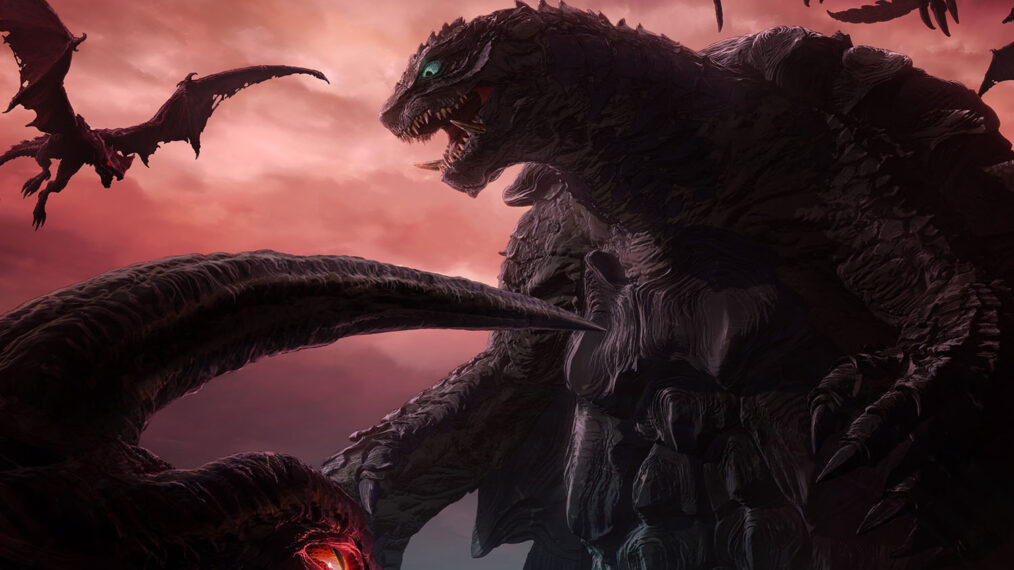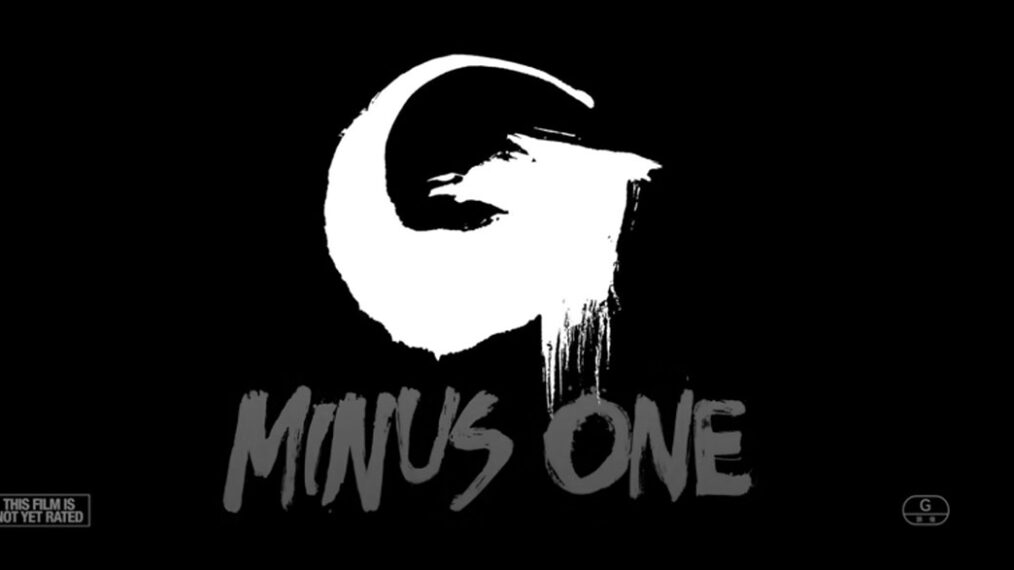‘Destroy All Monsters’: How Earlier Toho Films Led Up to the Studio’s Classic 1968 Kaiju Crossover
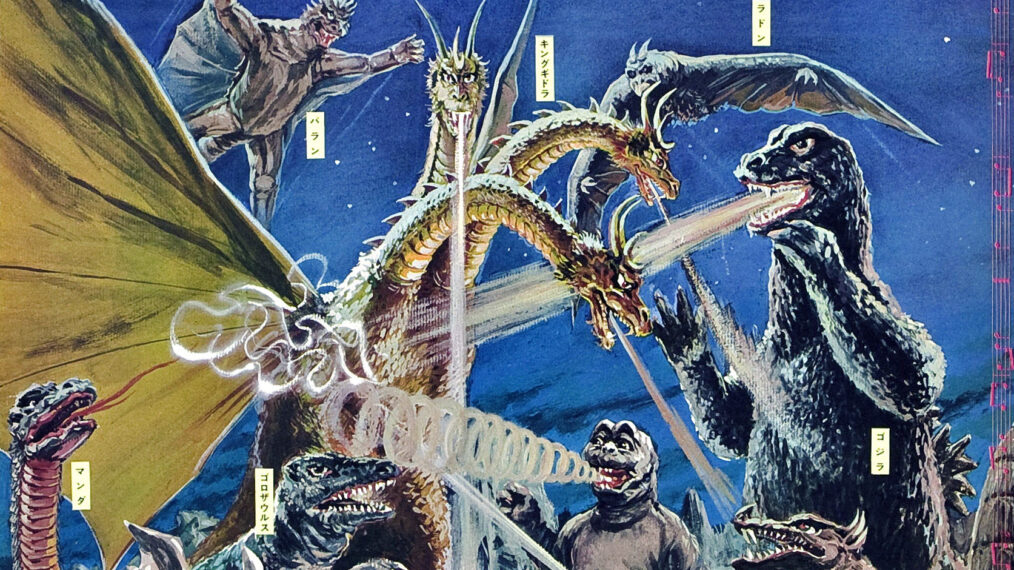
While Marvel may have done exceptional jobs at bringing characters and events in its movies together, especially with Avengers: Infinity War (2018) and Avengers: Endgame (2019), those weren’t the first times that cinematic universes have featured crossovers.
Some Universal Monsters appeared in “team up” or “monster rally” films back in the 1940s, and even more notably, Toho Studios brought together a number of its major big-screen kaiju into an “endgame” type situation in 1968’s Destroy All Monsters.
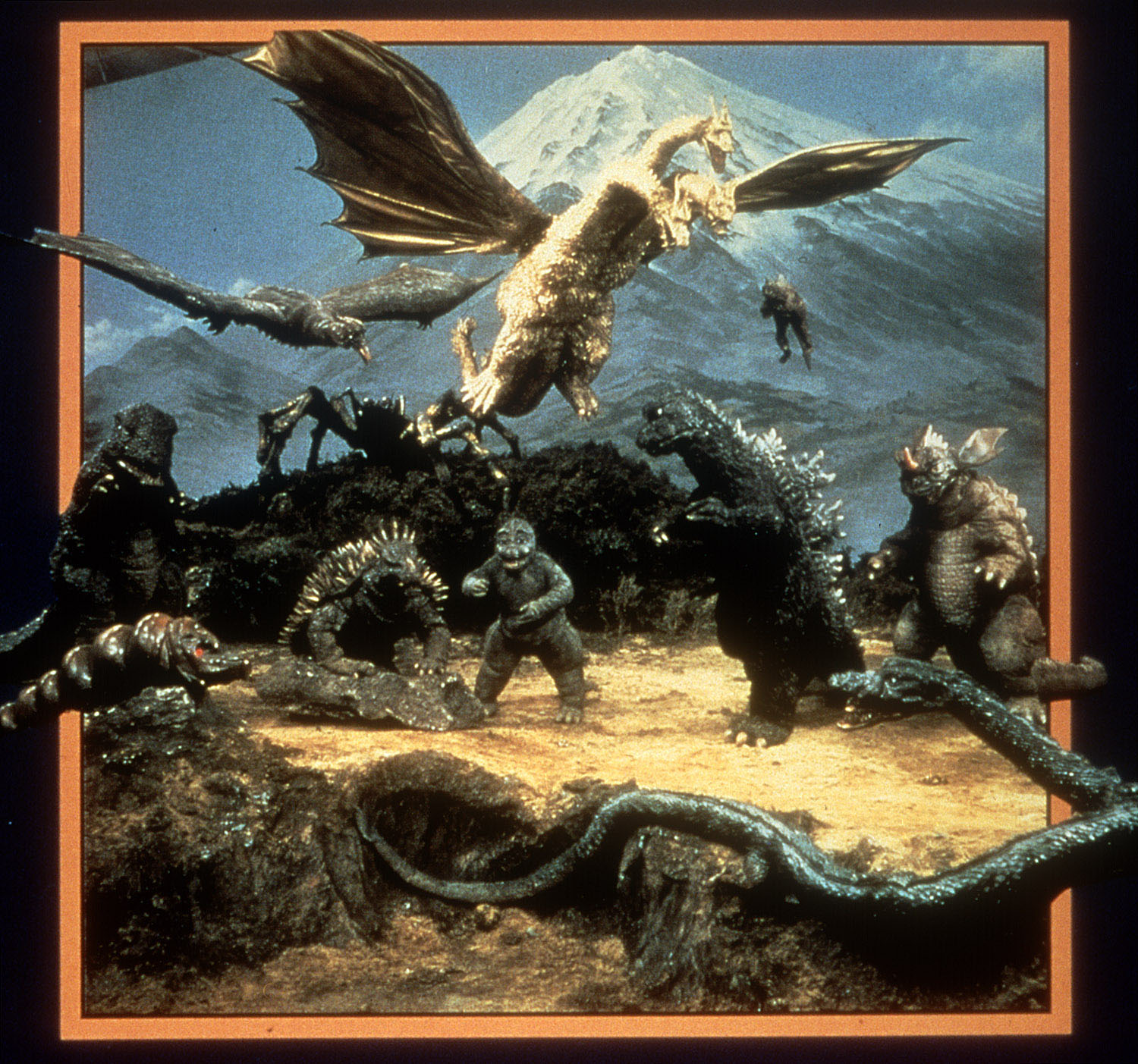
© Toho Co. Ltd./Courtesy Everett Collection
It’s cool how 11 of Toho’s biggest stars — Rodan, King Ghidorah, Varan, Godzilla, Baragon, Manda, Minilla, Anguirus, Mothra, Gorosaurus and Kumonga — put aside their egos to star in this passion project.
I don’t think Toho had a Marvel-like grand design for a “Phase 1” that would lead up to Destroy All Monsters, or anything like that. The film was not even the end of the initial era of Godzilla-verse movies that began in 1954 (several more films would follow DAM, up to 1975’s Terror of Mechagodzilla, before the franchise took about a 10-year hiatus), even if it would have served as a good climax for all that came before.
It just seems like the filmmakers thought it would be fun to bring all these creatures together … and it is! Destroy All Monsters has been my favorite Godzilla movie since I saw it at the theater sometime in the mid-’70s, when I was 6 or 7 (I think it must have been re-released around the time Godzilla vs. Megalon finally came to U.S. theaters in 1976; I recall seeing that one around the same time.)
DAM may have even been the first Godzilla movie I ever saw, and I guess I was lucky to have seen such an enjoyable one that immediately made me a fan of the big guy and the other creatures around him, as well as of Toho and various kaiju productions from other companies.
The movie features the grand architects of the Godzilla franchise — director Ishirō Honda, music composer Akira Ifukube and special effects supervisor Eiji Tsuburaya — firing on all cylinders in a story set in what was then the far-off future, the end of the 20th century (the English dub of the film specifically says 1999).
In that future, all of the world’s monsters (which happen to live in and around Japan) have been gathered together on an island called “Monsterland,” where they are researched.
Unfortunately, a familiar scenario from many of these movies occurs when aliens once again gain control of the monsters and send them on paths of destruction in major cities around the world.
It’s bad enough when Godzilla attacks New York, and Mothra invades Beijing, among other threats, but the aliens end up saving Tokyo for their deadliest assault, when they send four monsters — Godzilla, Rodan, Manda and Mothra — into town for one of the more epic rampages/army-versus-kaiju battles in the series, accompanied by another of Ifukube’s stirring military march themes.
That theme is heard in the very nicely done montage in this video:
Ultimately, humans regain control of the monsters, but before they can send them after the aliens, the aliens have one final surprise up their sleeve: They send in King Ghidorah, one of the biggest of the franchise’s “big bads,” to attack Earth’s monsters.
Being from space, Ghidorah cannot be controlled by the humans, so this sets up an epic battle at Mt. Fuji, where Godzilla and company end up giving the three-headed monster a truly epic beat-down.
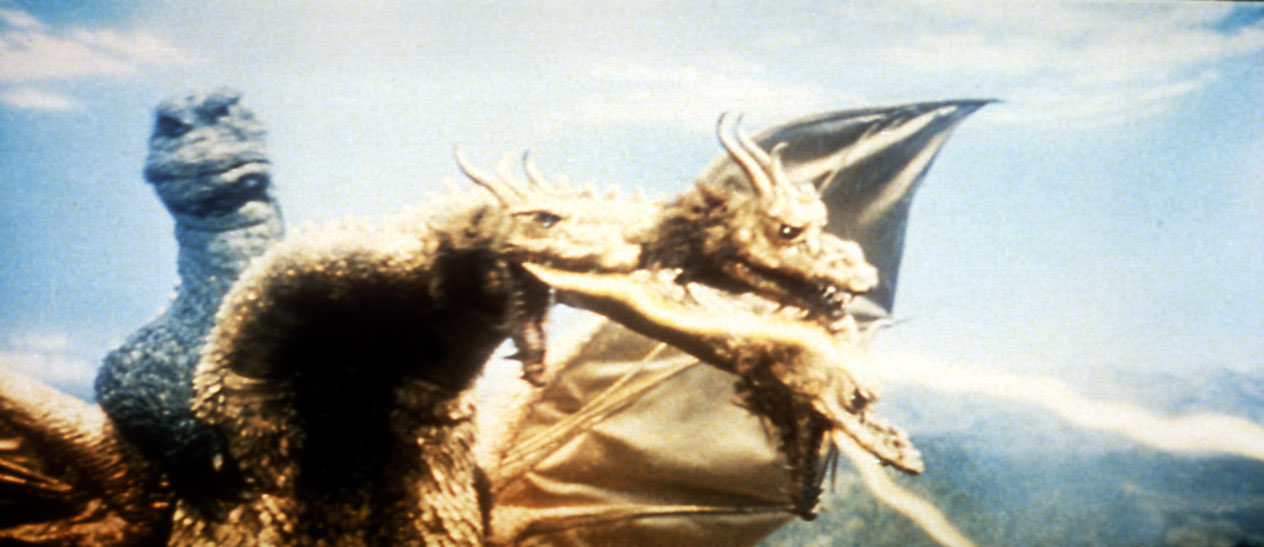
© Toho Co. Ltd./Courtesy Everett Collection
Setting the Stage For Destroy All Monsters — Characters, Themes & More From Earlier Toho Productions
Destroy All Monsters brought together many characters and themes from earlier Toho movies into one outstanding package. Some of the characters had evolved from what they had been in either standalone starring roles or bit appearances.
Notable Toho titles leading up to, and informing, Destroy All Monsters were:
Gojira (1954)
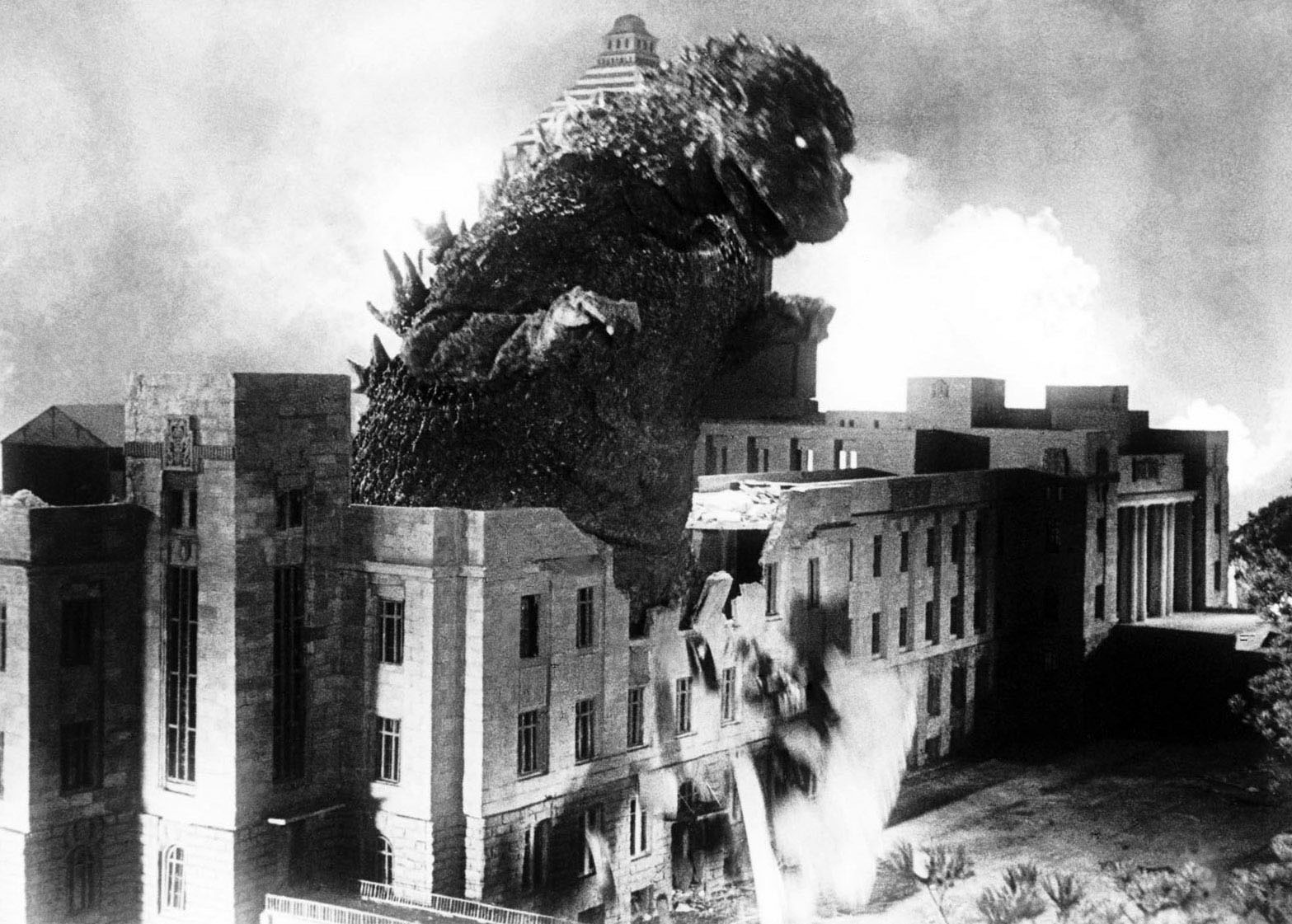
© Toho Co. Ltd./Courtesy Everett Collection
I don’t think I need to say very much about this legendary film, which introduced Godzilla and established the atomic-powered King of the Monsters as the terrifying existential threat, and source of fear and hatred among the populace, that he was in his first few movies.
While the Americanized version of this film, 1956’s Godzilla, King of the Monsters!, is fun, in its unedited, original Japanese version, Gojira is a true work of art, and Godzilla’s rampages here are genuinely frightening.
Godzilla Raids Again (1955)
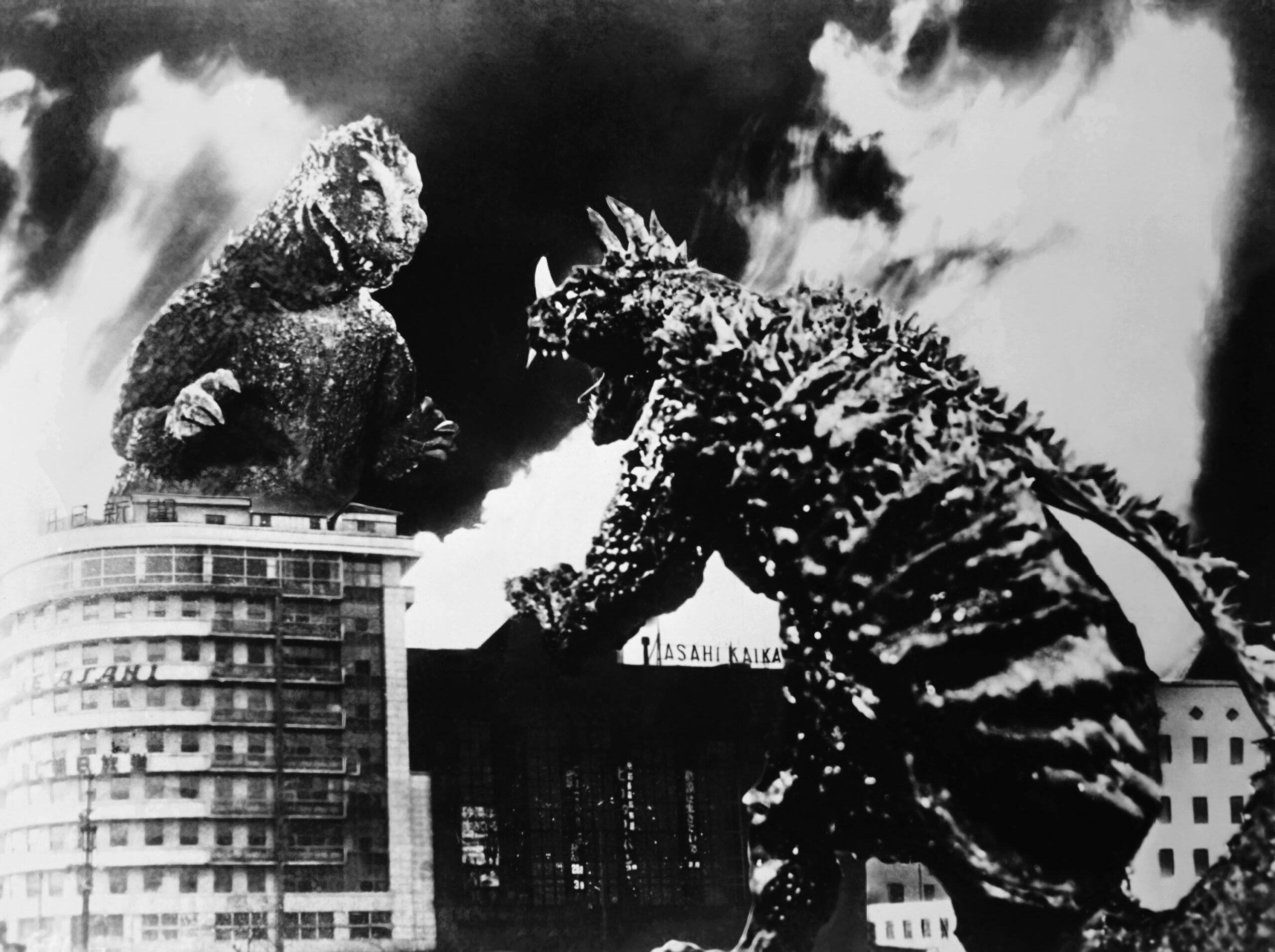
© Toho Co. Ltd./Courtesy Everett Collection
Future besties Godzilla and Anguirus started out at odds in Godzilla Raids Again
Specifically, it’s a second Godzilla (since the OG was killed by the Oxygen Destroyer in the first movie) that does the raiding in this first follow-up movie.
While the film is not as good as the original (partly because it is missing the hands of Honda and Ifukube), I do like that it moved the action away from Tokyo to other parts of Japan, including some snowy areas, which offsets nicely against Godzilla and the first of his foes: Anguirus, the four-legged, spiky Ankylosaurus that eventually became one of Godzilla’s fan-favorite allies in later films (including Destroy All Monsters, which finds plucky Anguirus eagerly diving first into the fray in the battle against Ghidorah).
But first, here, they clash. First on a snowy island, and then in downtown Osaka (I like how this battle simultaneously looks wild and brutal, and also like a couple of dogs play-wrestling.)
Then, it would surprisingly be a little while before either returned to the big screen.
Rodan (1956)
Rodan, the giant, Pteranodon-like flying monster, made his debut here. Like Godzilla, Rodan (and his mate; there are two Rodans in this movie) is a source of fear and destruction, and a far cry (or screechy roar) away from the lovable Godzilla ally he would be in later films like Destroy All Monsters.
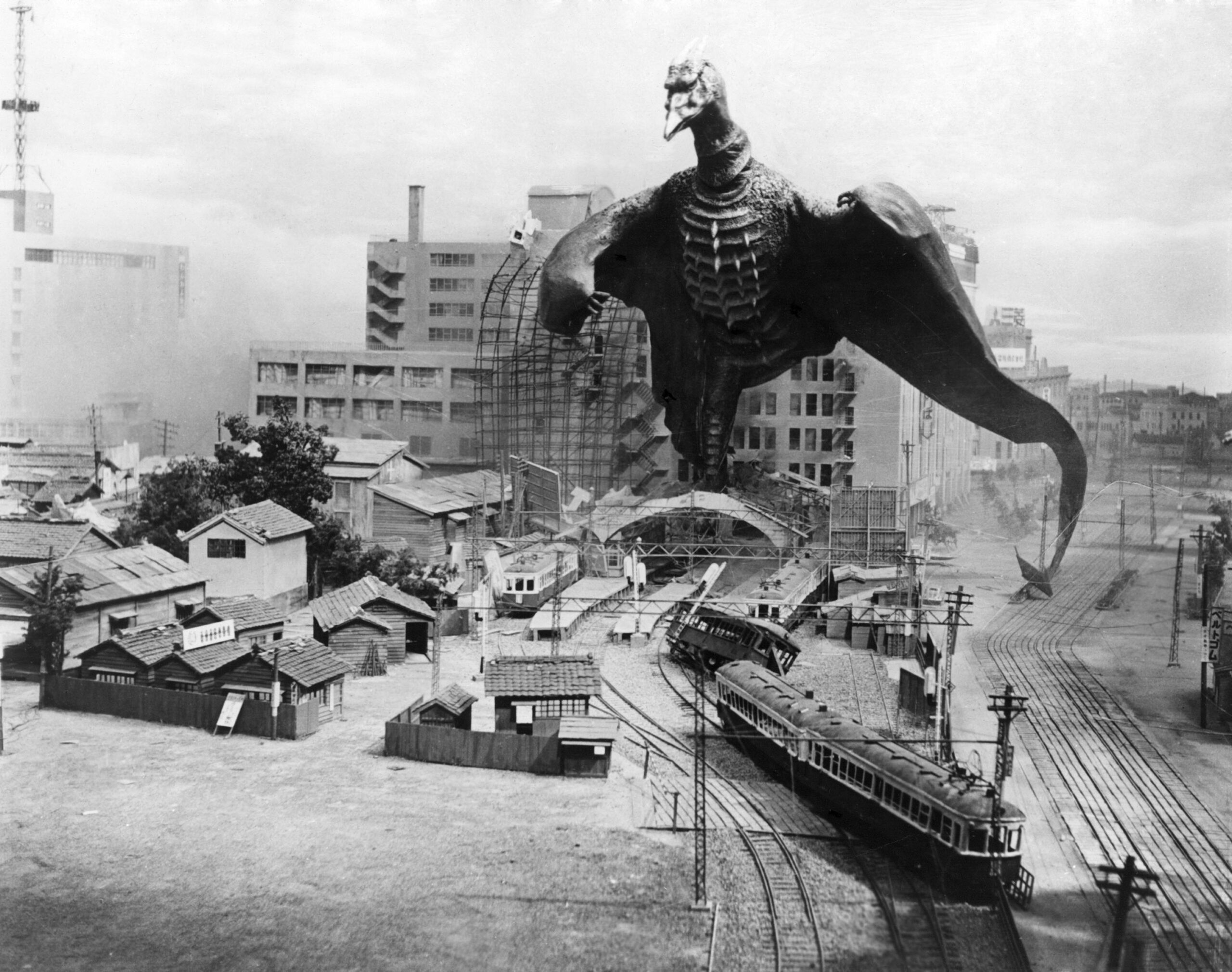
© Toho Co. Ltd./Courtesy Everett Collection
Honda, Ifukube and Tsuburaya again worked their magic to create another memorable monster with Rodan. But frankly, watching Rodan as a kid, I always found the Meganulon, those giant insects in the mine at the beginning of the film, to be a lot creepier.
Varan the Unbelievable (aka Giant Monster Varan (1958)
Honda, Ifukube and Tsuburaya again worked to create a new monster with this movie, but the fact that Varan is not nearly as remembered — and maybe not even known at all to any casual viewer — as other kaiju shows they weren’t as successful as they had been with Gojira and Rodan.
I vaguely remember seeing this movie only a few times on some creature-feature show when I was a kid. I’m sure I must have watched the heavily Americanized (and almost entirely reshot) English-language version, and that’s all I’ve been able to find available on streaming anywhere. I remembered that Varan was some sort of flying creature (in the photo at the very top of this post, you can see Varan in the upper right, kind of blurred and way in the back, flying against the backdrop of Mt. Fuji).
I swear I recall reading in a TV guide description of the movie that he was a mutated flying squirrel, so I spent decades racking my brain over what that weird Japanese movie about a giant flying squirrel was, before the age of the internet allowed me to read up about what Varan actually was (and he was unbelievable, all right; basically a mashup of Godzilla, Anguirus and Rodan — a spiky reptile that could swim, crawl and fly).
It seems like even Honda was disappointed with the film, but he still managed to give Varan a shout-out in Destroy All Monsters! Very small cameos, to be sure, and even though he shows up at the final battle, he does absolutely nothing to help, but you can still see him there and elsewhere in the film (if you don’t blink!). I’m sure I missed him and/or had no idea who he was on my viewings of the movie as a kid.
One area where Varan excels is in its exciting and ominous score by Ifukube; if you listen to the main theme, you can hear a part that he clearly adapted for use in later monster battles, including the final one in Destroy All Monsters. So Varan did play some important role in DAM, if not in the actual fight!
Mothra (1961)
Mothra, Queen of the Monsters, made her debut here in both her larval and moth forms. Like Godzilla and Rodan, she poses a destructive threat to Japan, but that is only because she is in search of the two miniature women who have been abducted from her island (and who are “Mothra whisperers” who would appear in subsequent films to summon Mothra with some song or other).
Mothra also establishes its title creature as one of the bravest and most reasonable of the kaiju, and one that can be underestimated because she chooses violence only when necessary. But she can certainly kick ass when necessary, as in Destroy All Monsters.
Atragon (1963)
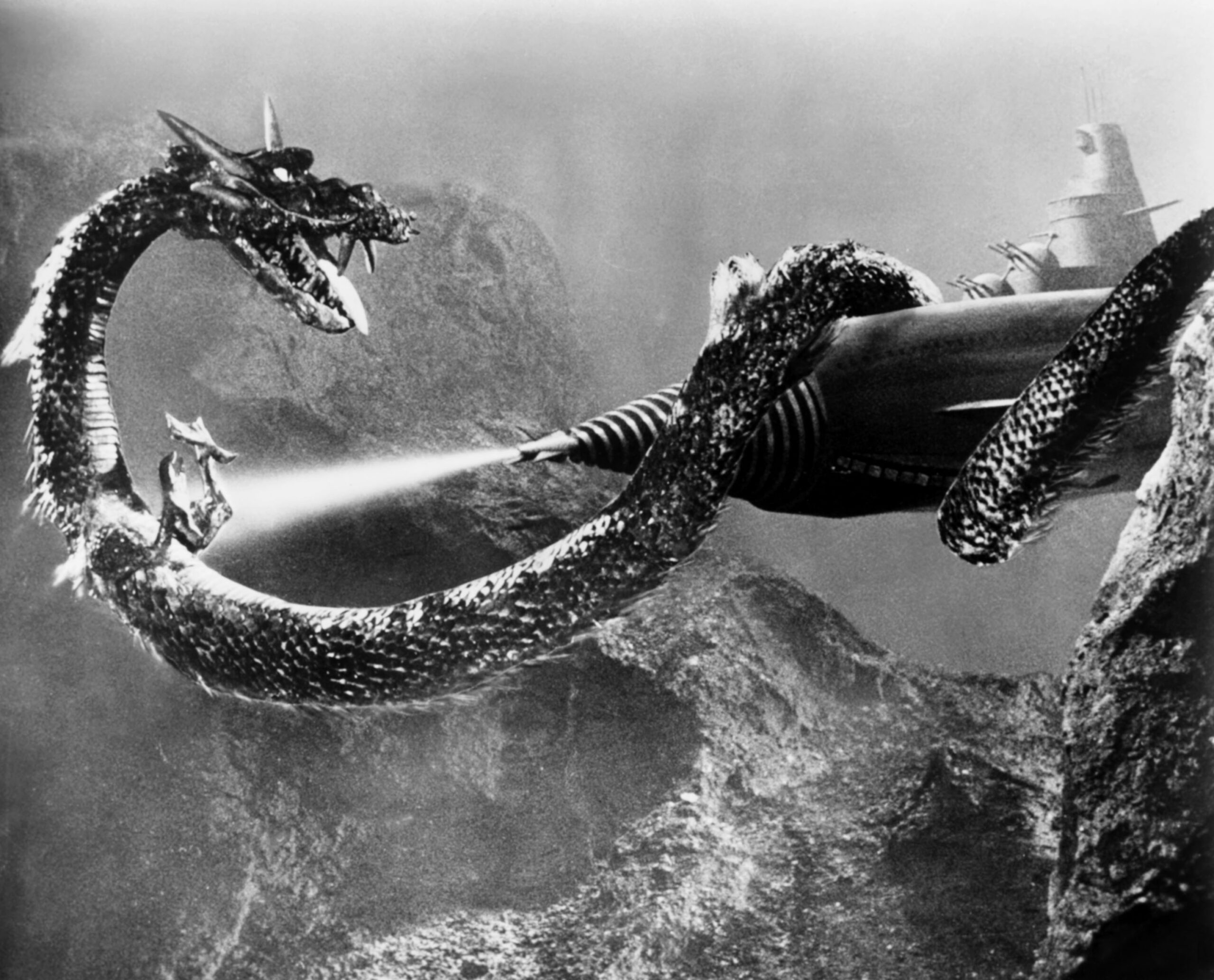
© Toho Co. Ltd./Courtesy Everett Collection
Snakelike sea dragon Manda features in some prominent Destroy All Monsters scenes, namely the attack on Tokyo along with Godzilla, Rodan and Mothra. He doesn’t do much at the final battle (he can’t do a lot given those little arms of his and the fact that he has to wriggle along, but land isn’t his best element, especially against a foe like Ghidorah).
You can really see what Manda is capable of courtesy of his debut in Atragon. He’s not in it a lot, but as god of a kingdom of undersea dwellers, he makes an impressively intimidating presence, especially when he is wrapping himself around a submarine.
He also displays his pretty cool roar, which is heard a good amount in Destroy All Monsters.
Mothra vs. Godzilla (1964)
After finally returning to the big screen in 1962’s King Kong vs. Godzilla, Godzilla continued in this title. Again, he is the bad guy, but this would be the last time in this early phase of the series that he was a purely frightening and destructive force.
He surely is one here, in his first of many meetings with Mothra, who gives Godzilla almost more than he can handle as she tries to defend her enormous egg from him before she dies. Her larval offspring then hatch, however, and finish the job she started of driving Godzilla away.
Ghidorah, the Three-Headed Monster (1964)
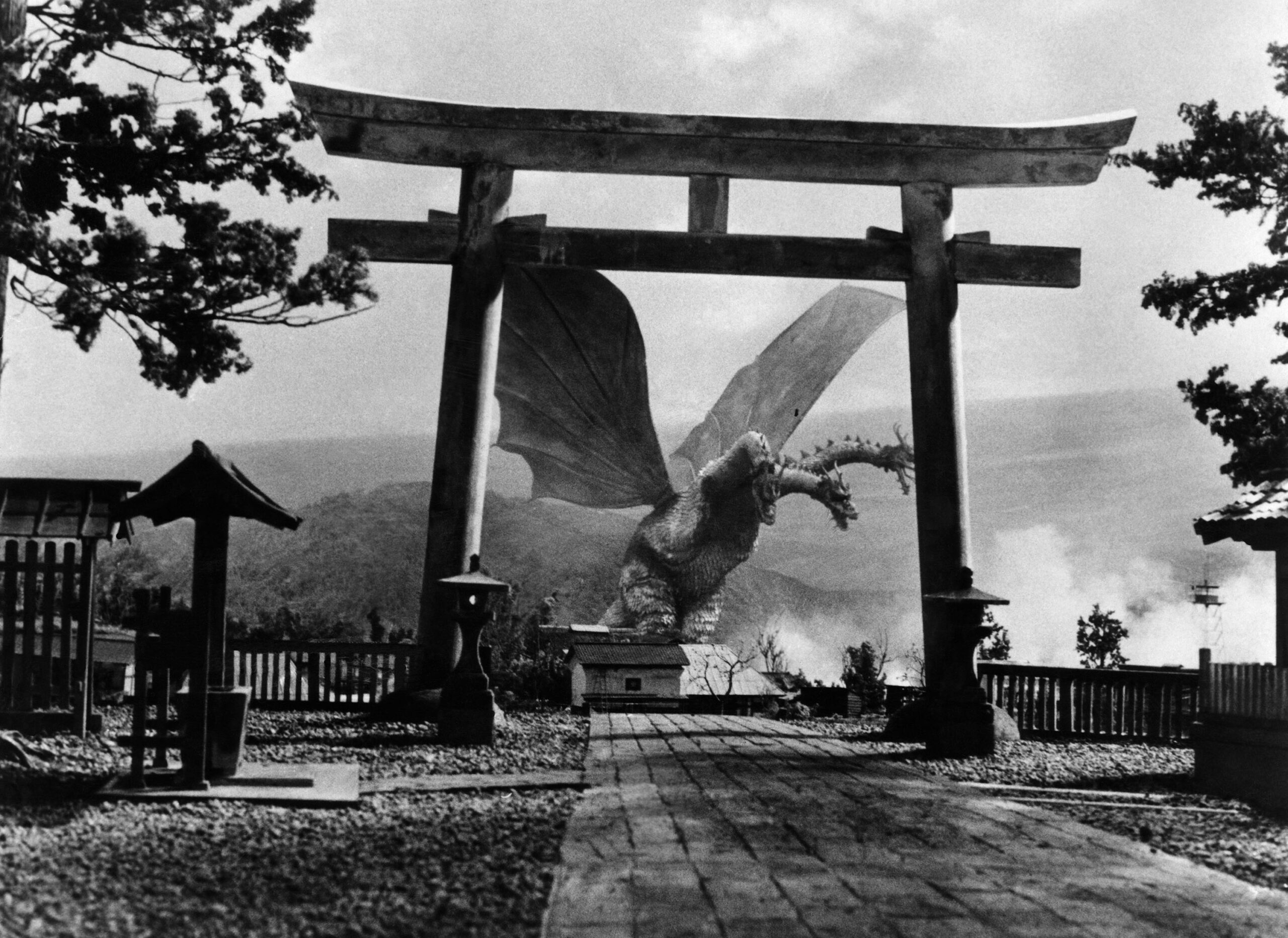
© Toho Co. Ltd./Courtesy Everett Collection
One of the most beloved bad guys in the Godzilla franchise, King Ghidorah of course made his debut in this self-titled film, which also stars Godzilla, Rodan and Mothra — the first of Toho’s multi-monster meetups culminating in a cool battle, which would become a staple in the franchise, especially in Destroy All Monsters.
It also establishes the utter terror that Ghidorah and his attacks bring. The creepy design of his costume, accompanied by Ifukube’s theme (which, like his many others, would become familiar and recurring in future films), is really something, and it helped make Ghidorah one of the few Godzilla monsters who actually unnerved me a bit as a kid.
Like DAM, this one ends with the other monsters combining forces against the greater threat of Ghidorah. But it takes Godzilla and Rodan (in his first movie in eight years) some convincing, at first — by Mothra, of course — to stop fighting each other and turn their attention to the triple-headed space monster.
The initial fight between Godzilla and Rodan is one of my favorites, and begins to incorporate some of the humor and craziness that would be seen in subsequent kaiju clashes.
The film also marks a change in Godzilla, Rodan and Mothra’s allyship, and they would team up again, notably in Destroy All Monsters.
It also represented the beginning of Godzilla’s turn from heel to hero in these early films, on his way to becoming the lovable, and sometimes comical, protector of Japan we would see in Destroy All Monsters and other titles.
Frankenstein vs. Baragon (aka Frankenstein Conquers the World) (1965)
I vaguely recall seeing this film under its U.S.-release title of Frankenstein Conquers the World on TV as a kid, but I’ll admit I don’t recall anything about Baragon. I don’t think I was too into Japan’s weird version of the Frankenstein monster as portrayed here, so I may not have paid enough attention to it to notice the cool four-legged, reptilian, burrowing, subterranean monster that was in it.
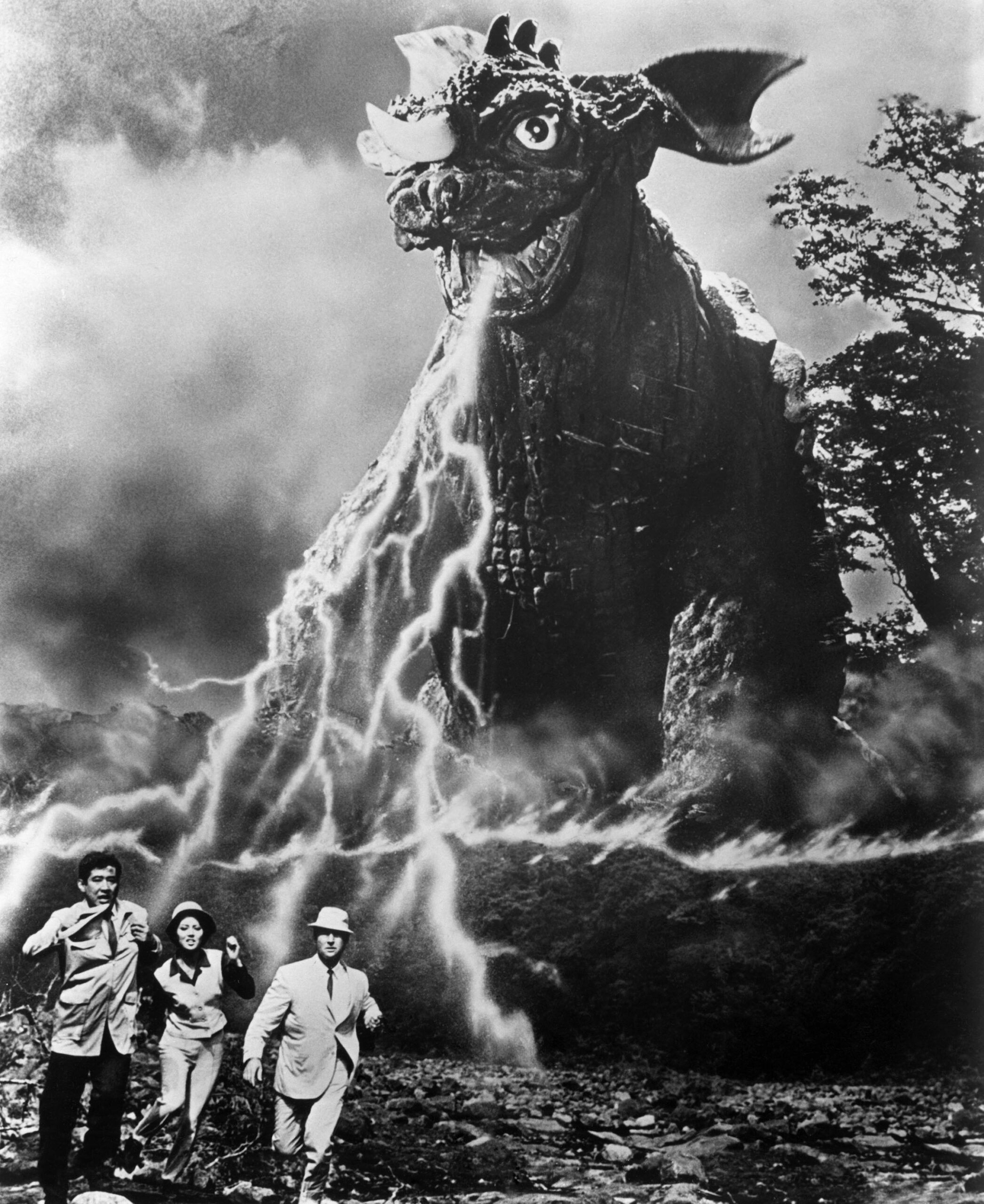
© Toho Co. Ltd./Courtesy Everett Collection
So when I would hear Baragon mentioned in Destroy All Monsters, or see him in his few scenes, I was confused as to who he was (it didn’t help that he was misidentified by the movie itself in one scene, where it is said that Baragon has shown up in Paris when onscreen it was clearly Gorosaurus burrowing up underneath the Arc de Triomphe).
But I know better, now, and have more respect for Baragon, even though he, too, did not contribute much to Destroy All Monsters‘ final battle. Still glad he was represented!
Invasion of Astro-Monster (1965)
Godzilla, Rodan and King Ghidorah were together again in this movie — and actually teamed up a bit to destroy cities, given they were under control for a while by aliens. This was the first movie in the franchise to use that plot idea, which would return in Destroy All Monsters.
As in that later movie, here, again, humans thwart the aliens’ control, and when Godzilla and Rodan snap out of it, they go to work against Ghidorah and kick his ass yet again.
King Kong Escapes (1967)
Gorosaurus may just be a basic dinosaur, but there’s something charming about him, even in his debut performance in this movie, one of Toho’s versions of King Kong that was even weirder than their version of the Frankenstein monster (this movie even had a Mechani-Kong years before there was even a Mechagodzilla).
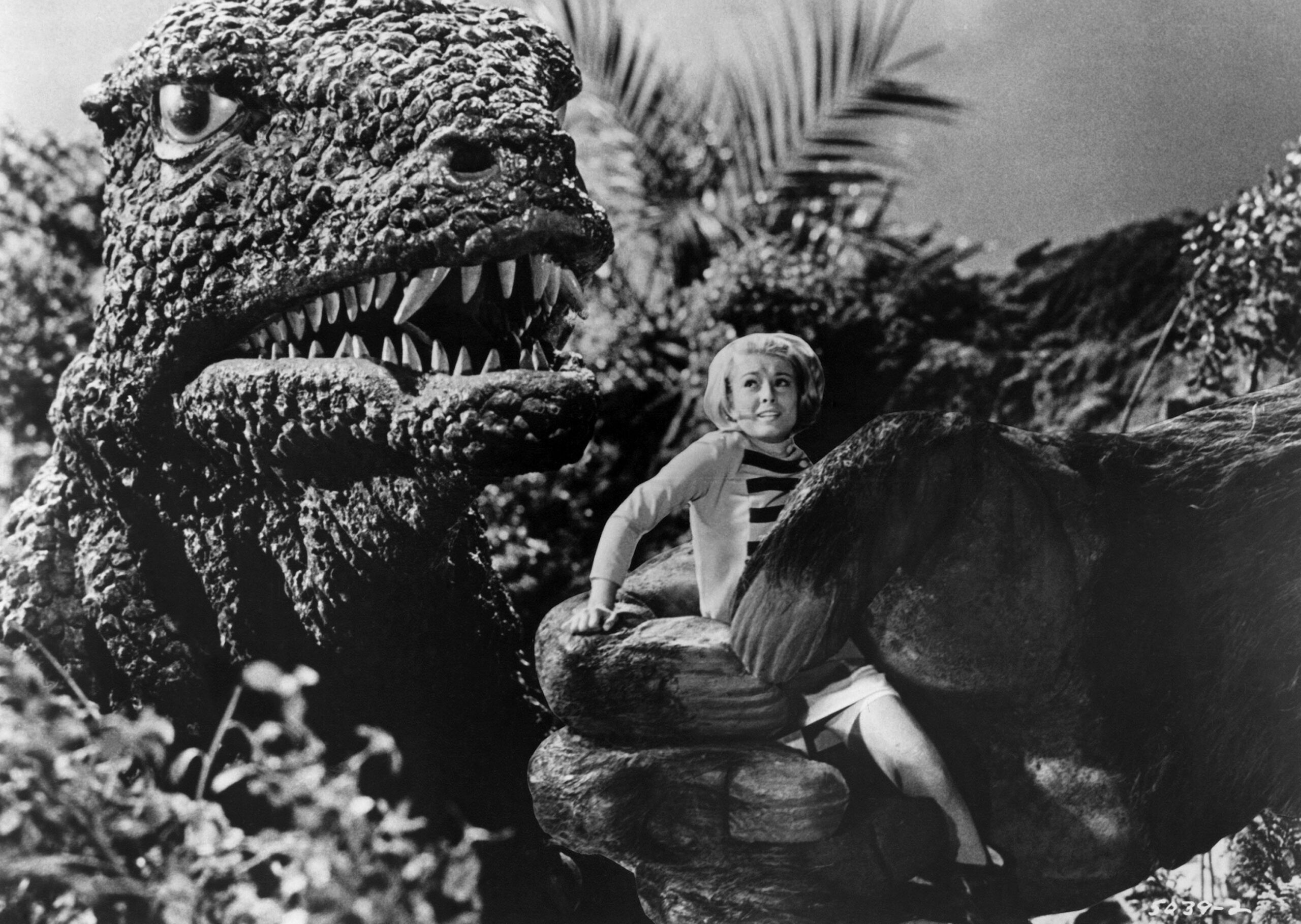
© Toho Co. Ltd./Courtesy Everett Collection
I especially love Gorosaurus’ hilarious trademark jump-kick that he uses in fights (seen in the video below); that move would prove key to getting Ghidorah on the ground for a final beatdown by the other kaiju in Destroy All Monsters, yet another nice callback by Honda and company.
Son of Godzilla (1967)
This film, which I’ve grown to appreciate as I’ve seen it more recently, introduced Minilla, Godzilla’s adopted son, and Kumonga, the giant spider. They all live peaceably on Monsterland in Destroy All Monsters after coming to blows in this movie, with Kumonga making a particularly creepy debut here, along with Kamacuras, giant mantis-like insects.
For some reason, in the English dub of DAM, Kumonga is referred to as “Spiga,” so that’s what I knew him as for a long time. He, along with Mothra, helps in the battle against Ghidorah by spinning his web across the foe.
And, for his part, Minilla shoots one little fiery ring out of his mouth that wraps around Ghidorah’s last moving neck, which puts him down for good. I guess that kind of justifies the flex that Minilla then does over Ghidorah’s body.

